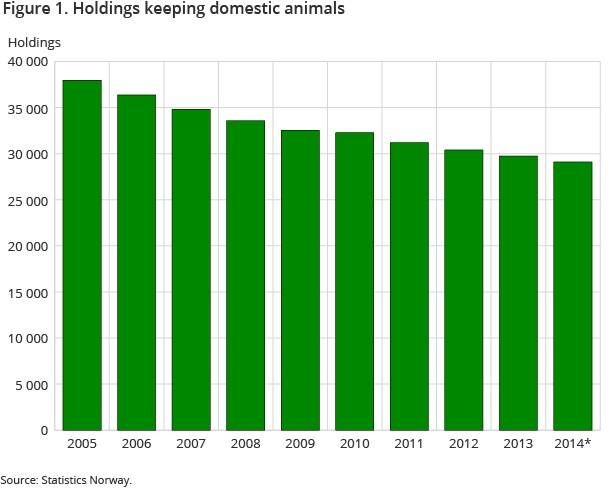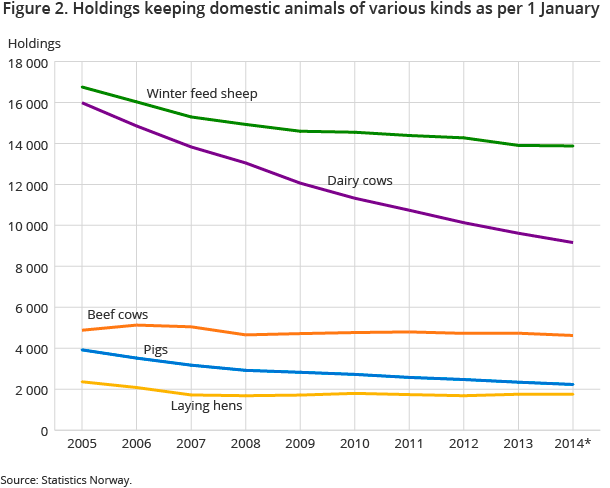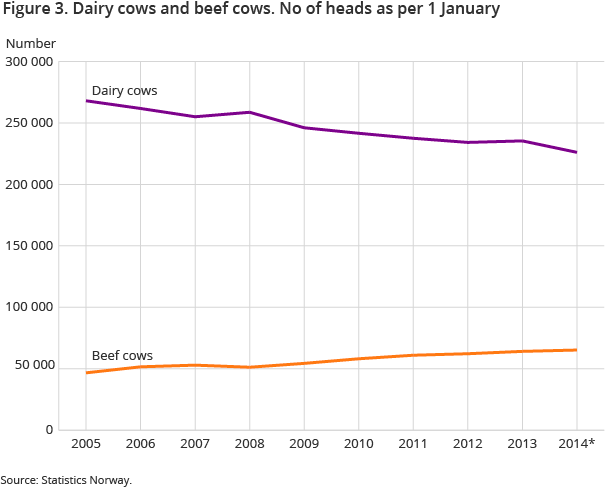Content
Published:
This is an archived release.
Fewer dairy cows
The number of dairy cows decreased by 9 300 to 229 500 from 2013 to 2014, while the number of beef cows increased by 1 100 to 68 600.
| 2014 | Per cent | ||
|---|---|---|---|
| 2013 - 2014 | 2005 - 2014 | ||
| Dairy cow | 229 487 | -3.9 | -15.5 |
| Beef cow | 68 638 | 1.6 | 37.0 |
| Winter feed sheep | 1 031 890 | -0.6 | -4.7 |
| Dairy goat | 30 211 | -8.0 | -34.4 |
| Pigs for breeding | 96 818 | -0.9 | -1.8 |
| Laying hens | 4 265 466 | 3.4 | 22.7 |
| Chicks for slaughtering | 70 586 521 | 12.4 | 77.5 |



As per 1 January 2014, a total of 832 300 cattle were registered; 19 300 fewer than the year before. The number of cattle other than dairy cows and beef cows was reduced by 11 100 to 534 200 in 2014. The number of dairy goats was reduced by 2 600 to a total of 30 200 in 2014.
From 2013 to 2014, the number of dairy goats dropped by 7 per cent to a total of 30 200. The number of breeding pigs and pigs slaughtered dropped by 1 per cent from the year before, to 96 800 and 1 556 900 respectively.
From 2013 to 2104, the number of holdings with dairy cows dropped by 5 per cent to 9 400, while the number of holdings with dairy goats dropped by 7 per cent to a total of 300. At the beginning of 2014, 14 100 holdings kept sheep; almost the same as the year before. About 2 000 holdings kept laying hens, while 700 had broilers. From 2013 to 2014, the number of holdings with broilers increased by 7 per cent.
The average holding with dairy cows had 25 cows in 2014, which is 8 more than in 2005. An average size holding with sheep had 73 sheep in 2014; 9 more than in 2005. The average holding with breeding pigs has grown from 44 breeding pigs in 2005 to 80 in 2014, and with laying hens from 1 400 to 2 200 in the same period.
Contact
-
Berit Bjørlo
E-mail: berit.bjorlo@ssb.no
tel.: (+47) 40 81 13 76
-
Cathrine Gran Øverby
E-mail: cathrine.overby@ssb.no
tel.: (+47) 40 85 46 03
